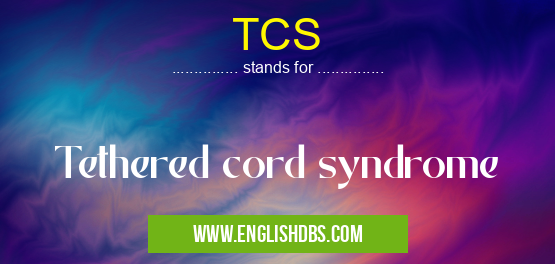What does TCS mean in PEDIATRIC
Tethered cord syndrome (TCS) is a rare condition in which the spinal cord is abnormally attached to the spinal column or other structures within the spinal canal. This abnormal attachment can cause the spinal cord to be stretched or tethered, leading to a variety of neurological symptoms.

TCS meaning in Pediatric in Medical
TCS mostly used in an acronym Pediatric in Category Medical that means Tethered cord syndrome
Shorthand: TCS,
Full Form: Tethered cord syndrome
For more information of "Tethered cord syndrome", see the section below.
Causes
TCS can be congenital, meaning it is present at birth, or it can be acquired later in life. Congenital TCS is usually caused by a failure of the spinal cord to separate completely from the neural tube during fetal development. Acquired TCS can result from trauma, surgery, or infection.
Symptoms
The symptoms of TCS can vary depending on the severity of the condition and the location of the tethering. Common symptoms include:
- Back pain
- Weakness or numbness in the legs or feet
- Difficulty walking or running
- Incontinence of urine or stool
- Scoliosis (curvature of the spine)
- Orthopedic deformities
- Neurological deficits
Diagnosis
TCS is typically diagnosed based on a combination of a physical examination and imaging tests, such as an MRI or CT scan. The imaging tests can help visualize the spinal cord and identify any abnormalities.
Treatment
The treatment for TCS typically involves surgery to release the tethered spinal cord. This surgery can be performed either through an open incision or laparoscopically. Following surgery, physical therapy and rehabilitation may be necessary to help improve mobility and function.
Essential Questions and Answers on Tethered cord syndrome in "MEDICAL»PEDIATRIC"
What is tethered cord syndrome (TCS)?
Tethered cord syndrome (TCS) is a condition in which the spinal cord is abnormally attached to the surrounding tissues, such as the vertebrae or the dura mater (the membrane that covers the spinal cord). This abnormal attachment can stretch or damage the spinal cord, leading to a variety of symptoms.
What are the symptoms of TCS?
The symptoms of TCS can vary depending on the severity of the condition and the location of the tethering. Common symptoms include back pain, leg weakness or numbness, incontinence, and difficulty walking. In children, TCS can also cause developmental delays.
What causes TCS?
TCS can be caused by a variety of factors, including spina bifida, spinal cord injury, and tumors. In some cases, TCS is present at birth (congenital), while in other cases it develops later in life (acquired).
How is TCS diagnosed?
TCS is diagnosed based on a physical examination and a medical history. Your doctor may also order imaging tests, such as an MRI or a CT scan, to confirm the diagnosis.
How is TCS treated?
The treatment for TCS depends on the severity of the condition. In some cases, no treatment is necessary. In other cases, surgery may be necessary to release the tethering and prevent further damage to the spinal cord.
What is the prognosis for TCS?
The prognosis for TCS depends on the severity of the condition and the timeliness of treatment. With early diagnosis and treatment, most people with TCS can live full and active lives.
Final Words: Tethered cord syndrome is a serious condition that can lead to significant neurological disabilities. Early diagnosis and treatment are important to prevent or minimize these disabilities. If you experience any of the symptoms of TCS, it is important to see a doctor for a proper diagnosis and evaluation.
TCS also stands for: |
|
| All stands for TCS |
